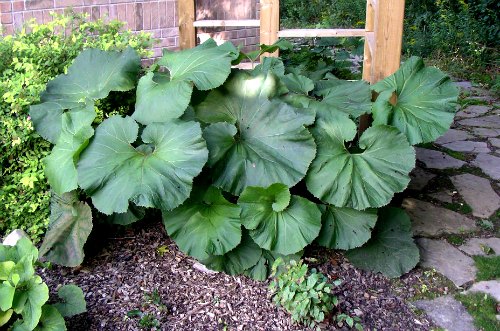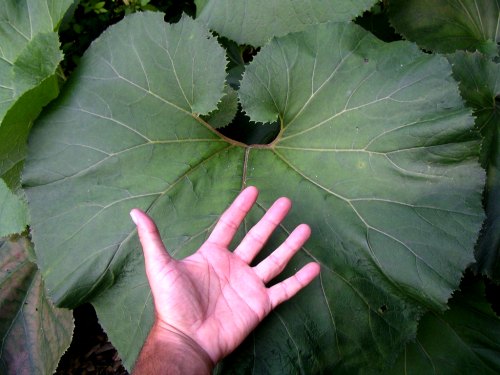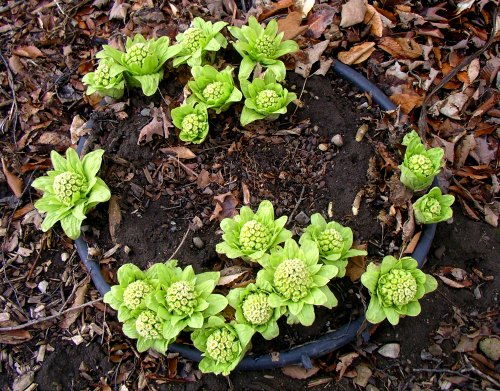Plant of the Month for May, 2015

(pet-uh-SY-tees juh-PON-ih-kus)
General Information:
A giant for the garden. Petasites japonicus is a spectacular plant that gets a lot of attention in the garden. Unfortunately, it spreads rapidly and is not suitable for all gardens unless you can contain it. I have had success doing this for several years by planting it in a large tree sized, bottomless, plastic pot which you can see in the picture of the flowers. The creeping rhizomes grow almost at soil level and do not get out of the pot.

Petasites japonicus; photo by Robert Pavlis
Petasites japonicus isone of the first plants to flower in zone 5. They are not spectacular, but they do make a very interesting show at a time where little else is flowering. The leaves don’t start to grow until flowering is complete. The flowers are dioecious, so it will not spread by seeds unless you have both male and female plants. In England most plants are males.
The common names for Petasites japonicus include fuki, bog rhubarb and sweet coltsfoot, but it is most commonly called giant butterbur.

Petasites japonicus; photo by Robert Pavlis
A subspecies called Petasites japonicus ssp giganteus also exists. Both names seem to be used interchangeably in the common literature and it is not clear to me, what the differences are. The name Petasites japonicus ‘Gigantea’ is also used but I believe it is an incorrect name.
There may be two varieties in gardens that are differentiated by the hairiness of leaves and stems. The pictures in this post have smooth new leaves, and fairly smooth leaf stems. A second variety has quite fuzzy new leaves that retain the hairs as they grow. The petiole are also very hairy. The Denver botanical garden has several accessions, including both varieties, but they have lost historical records for their sources of these plants.

Petasites japonicus flowers; photo by Robert Pavlis
The giant butterbur likes to grow wet, and can grow in heavy shade. Leaves can be expected to be bigger with more sun, but it may spread even faster there. The leaves are fairly thin and collapse in the heat of the sun if they don’t get enough moisture. They are also damaged by winds and hail.
Life Cycle: perennial
Height: 120 cm (4 ft)
Bloom Time: early spring
Natural Range: Japan
Habitat: wet boggy areas
Synonyms: Nardosmia japonica subsp. Japonica, Petasites albus
Cultivation:
Light: full sun(in water) to deep shade
Soil: any
Water: wet to boggy preferred, but will grow well in normal shade gardens
USDA Hardiness Zone: (3?)4– 9
Propagation: division
Seedex availability (ORG&HPS annual Seed Exchange): never
